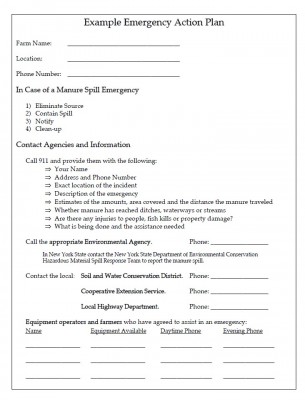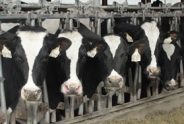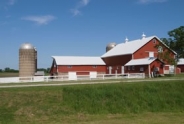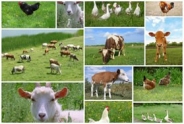Manure-Handling Emergency Action Plans

By Mike Hunter, NYSIPM
Adapted and reprinted with permission from Dairy Manure Systems: Equpment and Technology (NRAES-143). Natural Resource, Agriculture, and Engineering Service, P.O. Box 4557, Ithaca, NY 14852-4557. < www.nraes.org >
Every farm, regardless of size, that handles animal waste must be prepared to manage a manure-handling emergency. Manure-handling emergencies usually involve a discharge or spill of manure and therefore they pose a threat to human and environmental health. While prevention is the best strategy to reduce the risk of this type of emergency, not all manure spills can be prevented; therefore, a written emergency action plan must be developed for every farm. An emergency action plan is implemented in the event of a manure discharge or spill. The plan addresses the following areas: eliminating the source, confining the spill or runoff to as small an area as possible, assessing and recognizing the problem, notifying the proper authorities, and cleaning up the spill or runoff.
Each farm should identify all locations where system failure may occur, and how serious a problem it may present. This part of the emergency action plan involves determining possible solutions for anticipated emergencies. It must address ways to eliminate or stop the source of the spill or runoff. This pre-planning strategy will also serve as an educational tool for the employees. All employees, even those not directly responsible for animal waste equipment, should be familiar with the manure handling system. For example, they should know the location of all valves, how they function and how to turn them off.
Methods to confine the spill or runoff to as small of an area as possible must also be included in an emergency action plan. Containing liquid manure or runoff will likely require creating temporary diversions, digging holes or using soil to form emergency dikes. Incorporation of the manure into the soil surface will also reduce runoff from a field. To confine spills quickly, equipment must be available for immediate assistance. Operations that do not have a bulldozer, backhoe or tillage equipment should include a list of equipment owned by those who have agreed to assist in an emergency. In addition, other equipment that should be available includes: a liquid manure tanker truck, a vacuum tanker, a manure pump, manure irrigation equipment and inflatable tile plugs.
After any manure spill or runoff occurs, a process to assess and identify the problems must be followed. Most emergency action plans contain a list of questions to be answered. The following are suggested questions to consider: Did the manure reach any surface waters? Approximately how much manure was released and for what duration? Was there any damage noted, such as employee injury, fish kills, or property damage? Did the spill leave the farm property? Does the spill have the potential to reach surface waters? Have potable water wells been threatened? The written responses to these questions should be kept for future reference and emergency response training.
Notification of the proper agencies and local authorities must been done in a timely manner. If the spill leaves the property or enters surface waters, call local EMS officials. Agencies that will be able to provide advice and technical assistance include: local Soil and Water Conservation Districts, local Natural Resources Conservation Districts and the Cooperative Extension Service. Information to provide when calling agencies include: your name, telephone number, nature of the emergency, location of the spill including address and site description, the direction of spill movement, the immediate perceived impact, and any control action implemented.
Clean up efforts in manure spills or runoff should be documented and kept with the emergency action plan for future use. Written documentation should include the cause of the emergency, the procedure used to handle the emergency, a list of authorities that were called and those that responded, and the time it took for authorities to respond. The state water quality agency or other technical assistance agencies may provide advice on handling the clean up of the manure emergency.
In summary, emergency action plans are a valuable tool for farms that handle animal waste. The plan serves many functions such as identifying potential risks, identifying resources required to control a manure-handling emergency and identifying available resources.
References:
Albrecht, J. E. Emergency Action Plan, South Carolina Confined Animal Manure Managers Certification Program, Clemson University.
Fonner, R. How Can I Develop an Emergency Response Plan for My Livestock Facility?, 1999 Livestock Waste Management Conference, Bioenvironmental Engineering at the University of Illinois Urbana-Champaign.
Livestock and Poultry Environmental Stewardship Curriculum. Emergency Action Plans.
Smith, J.M. Manure Spill Emergency Management, Ohio State, Extension, Auglaize County, Ohio.
State of New York, Department of State, Office of Fire Prevention and Control. 1993. Hazardous Materials Incident Command Workbook.
Upcoming Events
Crops, Cows & Critters - Southwest New York Dairy, Livestock & Field Crops Newsletter Sponsorship
December 19, 2025
Our two forms of publications feature research-based and timely information from our four specialists, listed to the right, along with local event notifications and Cornell University outreach. This information is provided to participants who range from dairy, livestock, and field crops producers to agricultural suppliers and consultants.
Weekly Email Update: Shared with 625+ households who have signed up with our program.
Monthly Paper Mailer: To reach our stakeholders and farmers who lack internet access, we send out a monthly mailer where your company's logo and contact information would be featured with a mailing list of 330+ households.
If you sponsor our weekly and monthly publications you reach approximately 955 households.
Visit our website to view our newsletters!
2025 Cornell Food Beverage & Animal Feed Manufacturer Survey
December 19, 2025
Industry and Educational Advocates for New York State's Food, Beverage, and Animal Feed Manufacturing industries:
As you know, NYS has a diverse food and beverage manufacturing industry, in both the types of industries that exist and the wide distribution of firms by scale. Many manufacturing firms have strong backward linkages to agricultural production sectors in the state that support both farm-level and downstream food industry firms and consumers. In collaboration with the New York State Department of Agriculture and Markets, a team from Cornell University's Charles H. Dyson School of Applied Economics and Management has recently rolled out the 2025 New York State Food, Beverage, and Animal Feed Manufacturer Survey. The industry will benefit from an updated assessment of the industry that informs private and public investments and opportunities to support firm growth and improved profitability.
Cornell Organic Field Crops & Dairy Conference
March 6, 2026
Waterloo, NY
Farmers, researchers, educators, and agricultural service providers from across the Northeast are invited to the 2026 Cornell Organic Field Crops & Dairy Conference, held Friday, March 6, 2026, from 8:00 a.m. to 4:30 p.m. at the Lux Hotel & Conference Center in Waterloo, N.Y.
Co-hosted by New York Soil Health and Cornell CALS, the annual conference brings together leaders in organic grain, dairy, and livestock systems to share practical tools, new research, and farmer-tested strategies to support resilient and profitable organic production.
Announcements
No announcements at this time.





